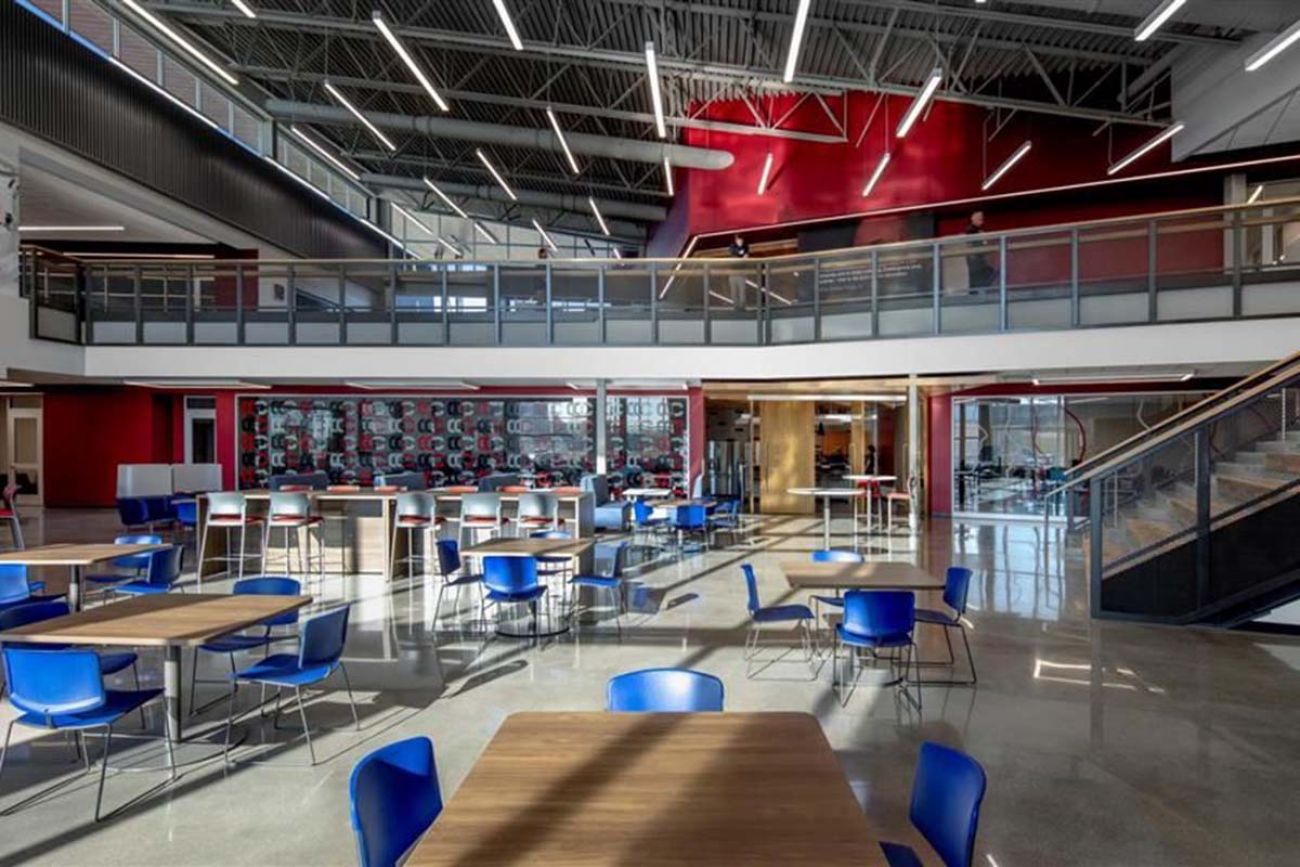$100M Kalamazoo career tech center shows promise, inequities in Michigan

KALAMAZOO—The potential, as well as the long-time problem, of career and technical education in Michigan can be found 45 miles apart in Southwest Michigan.
In Kalamazoo County, officials expect to break ground later this year on what may be the state’s most audacious experiment in career tech education: a $100 million CTE center, anonymously funded and maintained through a countywide tax millage. When it’s completed in two years, it will offer 25 programs ranging from computerized manufacturing to welding for a projected 1,500 students.
In neighboring Cass County, though, career tech students have a very different experience. There’s no state-of-the art tech center in the works, or any center at all. There are only five CTE class options based in high schools around the county, with districts scrounging for money to support student transportation.
Related:
- Michigan needs skilled workers, but lacks enough instructors to train them
- As Gretchen Whitmer pitches Michigan education, a lag in college enrollment
- Whitmer: Tap Michigan’s budget surplus to boost K-12, pre-K, mental health
Career and technical education varies wildly across Michigan because it is primarily funded through local millages, resulting in stark inequities between poor and more affluent districts. Low-income and minority students tend to have fewer options, creating an opportunity gap for training for skilled jobs that pay middle-class salaries at a time when Michigan businesses are struggling to fill job openings.
Kalamazoo’s planned career tech center highlights the increased importance of career tech education and burgeoning partnerships between schools and businesses desperate to find skilled workers. Leaders there hope it will be a catalyst to boost investment in CTE around the state.
While Kalamazoo Intermediate School Superintendent Dave Campbell beams with excitement over the opportunities the new tech center will offer students in his county, the longtime advocate for career tech education grimaces when asked about the disparities between the career tech “haves” and the “have-nots.”
“It makes me sick,” Campbell said. “Our funding structure screams inequity.”
Vocational education funding varies widely
Career and technical education is growing in Michigan, but students in some counties have fewer options because of uneven funding.
Source: Michigan Department of Education
Not your father’s vocational education
Those inequities have become even more noteworthy as interest in career tech has increased. Enrollment is up 21 percent across the state since the 2013-14 school. About 103,000 high school students were enrolled in at least one CTE class in 2020-21 in more than 2,000 programs, according to the Michigan Department of Education.
Democratic Gov. Gretchen Whitmer and her Republican predecessor Rick Snyder both praised career and vocational training as a means to improve Michigan’s economy and help students not attending college find good jobs, while giving a leg up to those going to college in technical fields.
“Career and technical education programs offer academic, technical and real-world skills that prepare our high school and college students for success today and rewarding, high-demand careers in the future,” Whitmer said in a statement released recently marking February as Career and Technical Education Month.
Far from the woodshop of the past, today’s high-tech and skill-based programs are focused on increasing the share of adults with post-high school credentials. Well-funded programs offer traditional CTE courses like auto mechanics and cosmetology, but also include options such as electronics and robotics, information technology and dental assistance.
“We have students who walk out the door and make $20 to $25 an hour,” said Mikki Spagnoli, director of CTE and post-secondary options at Heritage Southwest Intermediate School District, which provides services to districts in Cass County.
Students who have a CTE concentration graduate from high school in four years at a higher rate than Michigan students overall (96 percent to 82 percent). More than nine in 10 students who had a CTE concentration went on to enroll in a two- or four-year college, compared to 54 percent of high school grads overall.
Despite their popularity and academic bonafides, CTE programs have a different, and less consistent, funding stream compared to K-12 in general.
Most of Michigan’s public education system is funded in a similar fashion across the state, with the state providing money to local school districts and charter schools based on the number of students enrolled.
While CTE programs get some money from the state and federal government, programs are primarily funded locally through millages. In Michigan, 25 of the state’s 83 counties don’t have a millage that taxes property owners to pay for career tech. Schools in those counties tend to offer fewer CTE programs and have lower enrollment in those programs, because there is less money to pay for them.
For example, prior to passing a career tech millage in Kalamazoo County in 2019, that county’s CTE programs received about half a million dollars a year from the state, and a similar amount in federal funding, to operate a $5 million program. The other $4 million (80 percent of the total cost) was squeezed out of the general budgets of school districts and the intermediate school district that provides services for local districts. The millage vote more than doubled local program funding.
Without a CTE millage, “there’s always a disincentive to grow,” Kalamazoo ISD’s Campbell said. “You get more kids (enrolling in CTE), you have to have more teachers, and you have to bill the (districts).”
Even among counties with CTE millages, the amount raised varies wildly, from the equivalent of $1,005 for every K-12 student in Branch County, to $163 per student in Genesee.
Larry Good, president of the Ann Arbor-based Corporation for a Skilled Workforce, characterizes the inequities in career and technical education opportunities with one word: “Nuts.”
CTE in Michigan “grew out of local districts instead of growing out of state policy,” Good said. “So you had areas of the state that adopted millages to support that activity — including sometimes, a single district, like Ann Arbor — and others that didn’t.”
Even as Whitmer has pushed to equalize funding to schools, the state has done little to eliminate funding disparities in career tech, Good said.
“The demand (for CTE) from industry is enormous,” Good said. “(But) the state doesn’t put a lot of money into CTE.”
‘Beg, borrow and steal’
Cass County doesn’t have a CTE millage. Students in the county’s four school districts can choose among just five high school-based career tech programs. By comparison, students in neighboring Kalamazoo County, which passed the 2019 millage, have 20 options this school year and will have 25 when the county’s new career tech center is built.
Cass County’s Spagnoli said she “begs, borrows and steals” to keep the county’s few career tech programs open.
“All of us in CTE have a passion to make sure we give kids the opportunity to access CTE with the resources we have,” Spagnoli said, but “the way CTE is funded around the state does create a system of inequity.” The result is “kids (in Cass County) don’t get to experience or explore different career paths, they don’t know the possibilities of what their post-secondary options are.”
University of Michigan research currently underway has found that students in counties without a CTE millage have access to fewer career tech programs than students in millage-supported counties. Low-income and minority students have, on average, fewer CTE options than non-poor and white students, according to Jeremy Guardiola, senior project manager at U-M’s Youth Policy Lab.
“There are (CTE enrollment) gaps along racial and socioeconomic lines in counties with and without millages,” Guardiola said. “However, the size of those gaps is smaller in counties with millages.”
School-business collaboration
Money makes a huge difference in CTE enrollment.
Branch County, also in southwest Michigan, has the highest CTE millage in the state, at 4.2 mils (that’s $420 a year in taxes on a $200,000 home, with a taxable value of $100,000). Branch had almost triple the share of students in grades 10-12 enrolled in traditional CTE courses in 2017-18 compared to Kalamazoo and Cass counties, both of which didn’t have a millage at the time (36 percent in Branch, 14 percent Kalamazoo, 12 percent in Cass), according to an analysis of state data by Kalamazoo ISD).
Campbell said that until recently Kalamazoo students missed out on many opportunities to learn about careers, and businesses were missing out on potential employees. Campbell and business leaders began a series of meetings, coordinated in part by Southwest Michigan First, a business consulting and community development group, that culminated in the 2019 millage proposal that passed with 60 percent of the vote.
The 1 mil property tax now brings in $8.5 million a year for CTE in the county, which will be used to operate the new center when it opens.
That $100 million center was funded by an anonymous donor. The still unnamed center will be 170,000 square feet — or roughly 30 percent larger than the average Target store, and cost twice the price of a new high school.
The tech facility will be built on donated ground near the Wings Event Center near downtown Kalamazoo, adjacent to I-94. It’s designed by the architectural firm behind a similar state-of-the-art CTE center, Cherry Creek Innovation Campus, south of Denver, Colo.
The center will have the capacity to double or triple the 750 students now enrolled in CTE programs at high schools around the county, Campbell said. Some of those students now travel up to an hour one-way to get to a program at another school. When construction is completed for the center Kalamazoo, no trip from school to CTE will be more than 25 minutes.
Programs will include new classes in industrial design and supply chain management — which were recommended by businesses that helped plan the center.
“This conversation really ramped up in the past five years, because the workforce shortage is impacting us in almost every sector of industry,” said Carla Sones, president of Southwest Michigan First.
“If you drove right past where the new career tech education center is going to go and you just continue down along Sprinkle Road, you'll see ‘help wanted’ signs out in front of almost every facility,” Sones said, “from plastic injection molding, to the life science industry to the medical device sector.
“So the business community is thrilled about the concept of career technical education, having a world class center and being able to play a role in determining course curriculum,” Sones said.
“Not only because they see that as opportunities for them to invest in young people, and hopefully provide skills and opportunities that would help serve business later, but also, as an opportunity (for) students to recognize some of the great career options they have in the community.”
‘Kalamazoo Promise’ for CTE
School leaders from across the state who spoke to Bridge say they don’t believe a more equitable, state-level funding system for career tech is on the horizon. Campbell acknowledges it would be a “difficult pill to swallow” for the state to boost CTE funding to counties that have chosen not to pay for it themselves, when other communities have ponied up for their own programming.
One example: Alpena Public Schools, which operates a handful of CTE programs in its high school without a supporting millage. “More state money would be great,” said CTE director Joyce McCoy, “but local communities also should show they support it, too.”
“I don’t know that the answer is everyone should get the same (services),” said Doug Bush, associate superintendent for Gratiot-Isabella Educational Service District, which has a CTE millage. “Our voters were willing to pay a little more. My community shouldn't suffer because someone else’s community doesn’t put the same value on it as mine does.”
It’s unlikely Cass or many other Michigan counties has a donor willing to write a $100 million check for a state-of-the-art center like Kalamazoo’s.
But Sones and Campbell say Kalamazoo’s CTE expansion might serve as the same kind of catalyst for change as the Kalamazoo Promise, which since 2005 has offered free tuition and fees for in-state community college or public university for graduates of Kalamazoo Public Schools. That program sparked similar efforts around the country, including eight in Michigan.
Campbell said he’s encouraged by the fact that a community with philanthropists who invested heavily in college education through the Kalamazoo Promise now has a donor investing a huge sum in career tech.
There may not be a large donor in every county, but local businesses could boost CTE programs with donations of equipment or, possibly, employees who can be loaned out as instructors in high-tech programs. Similarly, schools could increase collaboration with businesses to shape career tech programs that fit the job market.
That would be music to the ears of Brian Calley, president of the Small Business Association of Michigan and former lieutenant governor under Snyder.
“We need all hands on deck for meeting the demands of the economy,” Calley told Bridge. “Exposure to a wide array of careers in our primary education system will help students make good decisions with more information and options to choose from. Robotics, computer science, welding, building trades and culinary programs are all important options.”
The CTE investment is already paying dividends in Kalamazoo.
Sones of Southwest Michigan First said she met recently with a company considering moving to the region. “They said, ‘We really want to meet the education community, because we want to know, is there a good partnership there? If we have an idea, is there a strong collaboration that we could vet the idea with educators?’
“It’s critical when you’re picking a location (to start or move a business) to know if that place supports you,” Sones said.
And $100 million goes a long way in showing that support. “We think this (CTE center) is going to make a statement,” Campbell said. “It will tell families and educators and businesses that career tech is important.
Funding for this article was provided through a Higher Education Media Fellowship sponsored by the ECMC Foundation and administered by the Institute for Citizens & Scholars, awarded to Bridge Michigan's Ron French.
Michigan Education Watch
Michigan Education Watch is made possible by generous financial support from:
Subscribe to Michigan Education Watch
See what new members are saying about why they donated to Bridge Michigan:
- “In order for this information to be accurate and unbiased it must be underwritten by its readers, not by special interests.” - Larry S.
- “Not many other media sources report on the topics Bridge does.” - Susan B.
- “Your journalism is outstanding and rare these days.” - Mark S.
If you want to ensure the future of nonpartisan, nonprofit Michigan journalism, please become a member today. You, too, will be asked why you donated and maybe we'll feature your quote next time!






